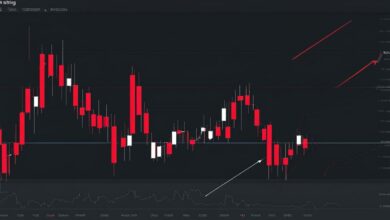Are Options Risky? Understanding the Potential Downsides

Introduction
Options trading has gained significant popularity in the financial markets due to its potential for high returns and strategic flexibility. Unlike traditional stock trading, options allow you to speculate on the future direction of asset prices without actually owning the underlying assets. This can offer substantial leverage but also introduces unique risks.
In this article, we delve into the risks associated with options trading. You will gain a comprehensive understanding of how to manage these risks effectively. By exploring key factors such as unlimited losses, contract complexities, liquidity issues, and time decay, we aim to equip you with the knowledge necessary to navigate the options market cautiously and confidently.
Additional Resources for Options Trading
We have also compiled some additional resources that will further enhance your understanding of options trading:
- Nvidia Stock Rally – A Chronology: Explore the Nvidia Rally Chronology with us, tracing the highs and lows of Nvidia stock and its market impact. This analysis can provide valuable insights into market trends and help inform your options trading strategies.
- Options Settlement: How are the contracts settled?: Understand the intricacies of options settlement and the procedures involved in closing contracts. This knowledge is crucial for effectively managing your positions and maximizing profits.
- What Is A Call Option?: Delve into the financial world with our comprehensive guide on Call Options. Understand its working, benefits, and how to use it effectively. Call options are a fundamental building block of options trading, so understanding them is essential.
Strategies for Options Trading Success
While this article primarily focuses on risk management, it’s equally important to explore strategies that can boost your chances of success in options trading. Some topics worth exploring include:
- Neutral Options Strategies: Discover neutral options strategies to bolster your portfolio! Ideal for any market conditions, these strategies provide a winning edge in the world of trading.
- Rolling Options: Unlock the potential of rolling options with our comprehensive guide. Maximize your profits and elevate your trading strategies to new heights.
- The Hidden Power of Open Interest in Option Contracts: Discover the significance of open interest in option contracts. Gain insights into market trends and investor sentiment for smarter investment decisions.
Importance of Testing Strategies and Gaining Experience
In addition to these resources, it’s important to test your strategies and gain experience before committing real money. Consider exploring the complexities of paper vs real money trading, weighing the pros and cons. This will help you step out of your comfort zone and boost your trading skills, ultimately increasing your chances of success in the options market.
1. Potential for Unlimited Losses
Options trading carries the inherent risk of potentially incurring unlimited losses for traders. This risk is especially pronounced in certain strategies, such as selling uncovered calls, where the potential loss is only limited by how high the underlying asset’s price can go.
Key Factors Contributing to Unlimited Losses
- Expiration and Exercising Options: The concept of expiration is crucial in options trading. An option’s value can drop significantly as it nears its expiration date, especially if it’s out-of-the-money. Timing when to exercise options is equally important; poor timing can result in substantial financial losses.
- Types of Risk: Different types of risks are associated with options trading, including market risk, volatility risk, and liquidity risk. Each of these can amplify potential losses if not managed properly.
Consider a real-life example: A trader sells an uncovered call option on a stock expecting it to stay below the strike price. However, if the stock price surges unexpectedly due to positive news or market conditions, the trader faces unlimited loss potential because they will need to buy the stock at an even higher market price to fulfill the contract.
To better manage risks and understand market dynamics, traders should explore various indicators and concepts that can provide valuable insights. For instance, understanding historical volatility vs implied volatility can help shape your trading strategy by analyzing past market trends and expected fluctuations.
Moreover, mastering tools like the RSI Indicator can provide a strategic edge in the market. This comprehensive guide helps you trade effectively and confidently by unlocking the secrets of this powerful indicator.
Furthermore, comprehending Option Moneyness is key to executing advanced strategies that maximize profits in the US market. This concept provides insights into the relationship between an option’s strike price and the current market price of the underlying asset, enabling traders to make more informed decisions.
Understanding these factors, along with exploring relevant indicators and concepts, is essential for navigating the complexities of options trading and mitigating potential downsides effectively.
2. Complexity of Options Contracts and Strategies
The complexity of options contracts and the various sophisticated strategies that traders can employ is a significant factor in options trading. Understanding these complexities is crucial for minimizing risks and maximizing potential returns.
Types of Options Contracts
- Call Options: These give the buyer the right, but not the obligation, to purchase an asset at a specified price within a set timeframe.
- Put Options: These provide the buyer with the right to sell an asset at a predetermined price before the contract expires.
Popular Strategies
- Covered Calls: Involves holding a long position in an asset while selling call options on that same asset to generate income from premiums received.
- Uncovered Calls (Naked Calls): Selling call options without owning the underlying asset, which can lead to unlimited losses if the asset’s price rises significantly.
Acquiring a thorough understanding of these complexities before engaging in options trading is essential to avoid unintended risks. If you’re interested in how options trading has evolved over time, this analysis provides valuable insights into key trends and changes in the market.
For those looking to compare different types of options contracts, our comprehensive guide on Call vs Put offers perspectives on which strategy may align best with your investment goals.
Understanding sophisticated strategies and their potential implications helps you navigate the intricacies of options trading with greater confidence. If you’re concerned about market volatility, exploring strategies for managing implied volatility can be beneficial in terms of risk management and maximizing returns even in volatile market conditions.
3. Liquidity Issues and Costs in Options Trading
Options trading can present unique challenges, particularly when it comes to liquidity issues. Low liquidity in certain options can lead to wider bid-ask spreads, making it difficult for traders to execute trades at desired prices. This discrepancy between the buying price (bid) and the selling price (ask) can significantly affect your profitability.
Potential Challenges Due to Low Liquidity
- Wider Bid-Ask Spreads: Low liquidity often results in larger gaps between bid and ask prices, which can eat into potential profits.
- Execution Difficulties: Finding a counterparty willing to take the opposite side of your trade becomes harder, especially under volatile market conditions.
Costs Involved in Options Trading
Trading costs are another critical aspect to consider:
- Bid-Ask Spreads: The spread can be a hidden cost that reduces overall profit margins.
- Commissions: Brokerage fees for executing options trades can add up, further impacting your net gains.
Understanding these elements is essential for effective risk management. To gain more insights into relevant trading strategies, you may want to explore our FX Spot vs FX Option trading comparison. This analysis helps skilled traders in the US make informed financial decisions by examining the differences between FX Spot and FX Option trading.
Additionally, it’s crucial to grasp the intricacies of exercising an option. This understanding allows you to navigate the fantastic world of finance more effectively and comprehend how it impacts your daily life.
For those interested in different types of options, you might find our guide on put options particularly useful. Put options are a strategic tool for investors in the U.S stock market, and comprehending how this financial mechanism works can provide you with a competitive edge.
Navigating these complexities requires careful planning and thorough research. Balancing costs with potential profits ensures a more sustainable approach to options trading.
4. Time Decay and Its Implications for Option Prices
Understanding the concept of time decay or theta is crucial for anyone involved in options trading. Time decay refers to the erosion of an option’s value as it approaches its expiration date. This happens because the longer an option has until expiration, the more time there is for the underlying asset to move favorably, which increases the option’s potential value.
Key Points:
- Time Decay (Theta): Theta quantifies the rate at which an option loses its value over time. For instance, if an option has a theta of -0.05, this means it will lose $0.05 in value each day, assuming all other factors remain constant.
- Expiration Dates: As expiration nears, time decay accelerates, significantly impacting short-term options more than their long-term counterparts.
Strategies to Mitigate Time Decay
To manage the negative effects of time decay:
- Engage in Shorter-Term Trades: By focusing on shorter-term trades, you can take advantage of rapid price movements without being overly affected by time decay.
- Select Options with Longer Expiration Periods: Options with longer expiration dates give more time for your trade to play out, thus reducing the daily impact of time decay.
These strategies help maintain value in your options portfolio and offset some risks associated with theta.
For further information on advanced techniques and levels of options trading, you might find this article about Level 3 Options Trading insightful.
If you’re looking to explore more advanced concepts and surprising facts about options approval levels, you’ll find these 5 surprising facts about options approval levels quite interesting.
By understanding and mitigating time decay, you can better navigate options trading and enhance your chances of profitability.
If you’re interested in expanding your trading knowledge beyond options and into the stock market, specifically momentum trading, you’ll find valuable techniques that can turn novices into experts. Unleash your potential in the stock market with momentum trading! Start mastering it today.
Evaluating Risks and Rewards: A Balanced Approach to Options Trading
Adopting a balanced approach in options trading means weighing advantages against risks. While the potential benefits can be substantial, it is crucial to understand the associated risks to make informed decisions.
Potential Benefits
Strategic options trades can generate significant profits. Here are some key opportunities:
- Leverage: Options allow you to control a larger position with a relatively small investment.
- Flexibility: Various strategies offer flexibility in different market conditions.
- Hedging: Options can serve as a hedge against other investments, reducing overall portfolio risk.
Risk Management Strategies
Effective risk management is essential when engaging in options trading. Consider these strategies:
- Diversification: Spread your investments across different assets to minimize the impact of any single loss.
- Position Sizing: Determine an appropriate position size relative to your total portfolio to manage risk.
- Stop-Loss Orders: Use stop-loss orders to automatically sell options that reach a predetermined price level, limiting potential losses.
Understanding these elements helps traders navigate the complexities of options trading.
For more insights on strategic sector rotations that could influence your options trades, visit FxOptions.
Additionally, familiarizing yourself with assignment processes can also aid in managing risks effectively. You should know when do options get assigned and understand the process to make more informed decisions.
To further enhance your understanding of options trading, it’s recommended to explore options quotes. This resource provides comprehensive information about the various components of an option quote and is a valuable asset in financial trading.
By combining awareness of both potential benefits and risks with appropriate strategies, traders can enhance their chances of success in the options market.
Conclusion
Understanding the risks associated with options trading is crucial for any trader looking to navigate this complex financial landscape. Key takeaways from this article include:
- The potential for unlimited losses due to factors like expiration and timing.
- The complexity of options contracts and strategies, emphasizing the need for a thorough understanding.
- Liquidity issues and costs that can impact profitability.
- The implications of time decay on option prices.
Informed decision-making is essential. By leveraging your newfound knowledge, you can approach the options market with both caution and confidence.
For further insights, explore our guides on equity options vs index options, options exchanges, and systematic vs unsystematic risk. These resources will enhance your understanding and help you make more informed investment decisions by exploring the key distinctions in ‘equity options vs index options’, unveiling insights into how ‘options exchanges’ operate, and gaining a solid grasp of the differences between ‘systematic vs unsystematic risk’.







